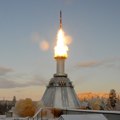Lower emissions from aircraft engines:
Experiments in zero gravity provide fresh impetus
27.11.2009, Press releases
Everyone is talking about carbon dioxide's effect on the climate. However, the harmful effects of nitrogen oxides are much more severe. For cars and trucks, the problem can be tackled with catalytic converters; not so for aircraft engines. Scientists at the Technische Universität München (TUM) are now focusing their attention on this problem.
When the European research rocket TEXUS-46 lifted off from Esrange, the European launch site near the Swedish town of Kiruna, at 12:15 pm local time on November 22, it had a special set of experiments on board. These were designed to analyze – in the zero gravity of the six-minute phase of ballistic flight -- the combustion of perfectly spherical drops of fuel of a defined size and a specified mutual separation. The aim of the experiments was to better understand how harmful exhaust gases are produced during the combustion of liquid fuels.
In comparison to the frequently discussed greenhouse gas carbon dioxide, the team headed by Klaus Mösl from the Thermodynamics Department of the TU Munich is concentrating on the emission of the poisonous nitrogen oxides (NOx), which are even more harmful to the environment. Although the quantity of carbon dioxide typically released is larger in absolute terms, the harmful effects of the nitrogen oxides are several times more severe. The poisonous nitrogen oxide exhaust gases are produced especially during the combustion of liquid fuels, such as kerosene and diesel fuel. For cars and trucks, the nitrogen oxide emissions can be reduced by aftertreating the exhaust gases with catalytic converters. For aircraft engines, the only solution is to use intelligent combustion control. The fuel must be burned in such a way that no nitrogen oxide is produced in the first place. Until now, development engineers have lacked the fundamental knowledge they need to adapt and optimize the existing technologies accordingly.
To confirm laboratory experiments and clarify unanswered questions, the Garching-based researchers entered into a collaboration with the Center of Applied Space Technology and Micro-gravity (ZARM) in Bremen and the Japanese Space Agency JAXA. Together they further developed, added to and optimized an existing experimental setup of the Japanese. While the Japanese scientists were interested in the principle of how a propagating flame fundamentally spreads across a series of drops, the TUM scientists collected exhaust samples. These were subjected to a detailed analysis in Garching after the scientific payload had been recovered at the beginning of the week. The crucial question for the TUM scientists was: How much of the initially liquid fuel must vaporize before ignition in order to achieve a significant reduction in the nitrogen oxide emissions?
In the 1980s, American scientists had predicted that less nitrogen oxide would be produced if more of the fuel in a spray of droplets had vaporized before it was ignited. Their assumption that there was a linear correlation was reported in many publications and text books. However, this assumption was largely incorrect, as Mösl’s experiments demonstrated. The experiments showed that pre-vaporization of the droplets initially has almost no effect; after a certain point, the amount of nitrogen oxide decreases dramatically with increasing degree of vaporization. This has an important implication for the engineers who design aircraft engines: Only when they have succeeded in vaporizing a high proportion of the fuel droplets before ignition will they be able to significantly reduce the emission of nitrogen oxide.
Researchers in the Thermodynamics Department are now working on developing calculation models and simulations from the correlations discovered, which design engineers could then use to develop new engines with lower emissions. “The chemical and physical laws can only be investigated under ideal conditions,” explains Klaus Mösl. “Only in zero gravity is the gas cloud of vaporized fuel ideally distributed around the remainder of the droplet.” For stationary gas turbines, the nitrogen oxide emission can be significantly reduced by pre-mixing and precise control of the combustion process. A lot of research work remains to be done, however, before this can be achieved for aircraft engines, with their great load changes.
The experiment was financed by the German Aerospace Center (DLR) and the European Space Agency (ESA). The results of the experiments will be used in various international projects.
Contact:
Technische Universitaet Muenchen
Chair for Thermodynamics
Dipl.-Ing. Klaus Mösl
Boltzmannstr. 15, D 85748 Garching, Germany
Tel.: +49 89 289 16241
E-Mail -
Internet
Kontakt: presse@tum.de
More Information
| 091127_texus-46_pi.pdf |
Druckversion der Presseinformation (DE),
(Type: application/pdf,
Size: 128.5 kB)
Save attachment
|




